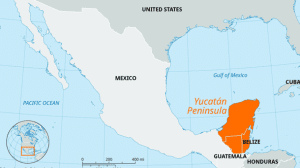TAG: GS 1: GEOGRAPHY
THE CONTEXT: A groundbreaking discovery in marine science has sent shockwaves through the scientific community, unveiling the true extent of Mexico’s Taam Ja’ Blue Hole (TJBH), located in Chetumal Bay off the Yucatan Peninsula.
EXPLANATION:
Blue Holes and Taam Ja’ Blue Hole (TJBH):
- Blue holes, also known as Karst formations, are geological wonders formed through the gradual dissolution of soluble bedrock such as limestone or gypsum.
- Over thousands of years, glacial runoff during the Ice Age carved these vertical marine caves beneath the ocean’s surface.
- The Taam Ja’ Blue Hole exemplifies the remarkable processes of nature, showcasing the intricate beauty of underwater landscapes shaped by geological forces.
- This natural wonder, known as a blue hole, has captured the attention of researchers worldwide due to its immense size and depth.
- The recent study, published in Frontiers in Marine Science, details the astonishing depth of the Taam Ja’ Blue Hole.
- New measurements taken during a December scuba-diving expedition reveal that the blue hole plunges a staggering 1,380 feet (420 meters) below sea level, making it the deepest blue hole ever discovered on Earth.
- Surpassing the previous record holder, the Sansha Yongle Blue Hole in the South China Sea, by 480 feet, the Taam Ja’ Blue Hole sets a new benchmark in underwater exploration.

Taam Ja’ Blue Hole
Challenges of Exploration
- Despite advances in technology, exploring the depths of the Taam Ja’ Blue Hole presents significant challenges.
- The lack of oxygen and the presence of harmful hydrogen sulfide gas create hazardous conditions for researchers attempting to reach the bottom.
- Even with state-of-the-art tools, including echo-sounders and CTD profiles, scientists have been unable to descend to the deepest reaches of the blue hole.
Ongoing Scientific Endeavors
- Discovered in 2021, initial measurements using echo-sounders provided only a glimpse of the Taam Ja’ Blue Hole’s depth, reaching 900 feet.
- However, a recent expedition equipped with enhanced technology, such as the cutting-edge CTD profile, provided further insights into the blue hole’s environment.
- Despite their efforts, researchers were unable to reach the bottom, as the cable stopped at 1,380 feet.
- Scientists hypothesize that the bottom may consist of an intricate network of caves and tunnels, yet to be explored.
Future Exploration and Discoveries
- Undeterred by the challenges, scientists remain determined to unravel the mysteries of the Taam Ja’ Blue Hole.
- Future expeditions aim to overcome technological limitations and venture deeper into the abyss, shedding light on the unseen realms hidden beneath the ocean’s surface.
- Each exploration brings the potential for new discoveries, enriching our understanding of Earth’s geology and the complexities of marine ecosystems.
Yucatan peninsula:
- The Yucatán Peninsula is a large peninsula in southeast Mexico and adjacent portions of Belize and Guatemala.
- The peninsula extends towards the northeast, separating the Gulf of Mexico to the north and west of the peninsula from the Caribbean Sea to the east.
- The Yucatán Channel, between the northeastern corner of the peninsula and Cuba, connects the two bodies of water.
- The peninsula is approximately 181,000 km2 (70,000 sq mi) in area. It has low relief and is almost entirely composed of porous limestone.



